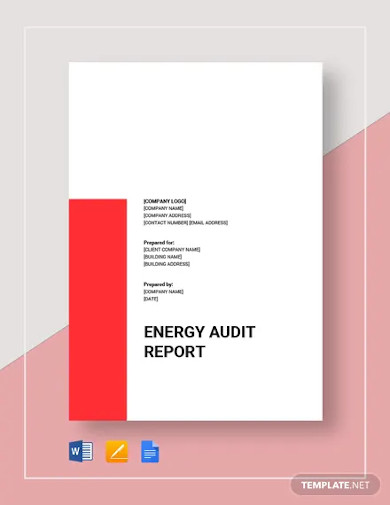What is the primary goal of an energy audit?
To measure air quality
To identify energy savings opportunities
To evaluate employee performance
To inspect building aesthetics

There are many reasons why we need to know about our commercial building or home’s electrical energy usage. One of them is to find out how much we’re gonna pay for it monthly. Businesses, however, have different motives. They conduct internal audits, such as facility audits, safety audits, and other auditing activities, to have a detailed basis for energy conservation or any plan for energy efficiency. Whatever audit methodologies are being used, they always involve evaluations and assessments whose results are recorded in an actual report document for future reference. If you’re given the task to create an energy audit report, our varieties of examples are perfect for you! Check them out below!.

An energy audit report is an output of program documentation, particularly for an energy audit activity. It narrates how the residential assessments or workplace assessments on the systems and tools relevant to energy went. Moreover, it presents the notable findings during the processes. According to the blog site, Diversegy, the implementations of energy audits can help organizations understand their electricity usage patterns and issues, like misspending of the said resources. The same source affirmed that having knowledge of these factors can help organizations scheme and carry out corrective action plans. It is through an energy audit report that every bit of the aforementioned details is recorded for safekeeping.
The United States Energy Information Administration (EIA) stated in their June 2020 report that the electricity demand is expected to reach 998 billion kilowatt-hours from June to August. According to them, this is the lowest electricity consumption for summer in the U.S. since 2009. The body blamed the Corona Virus Disease (COVID-19) pandemic for low consumption, saying that the virus forced commercial and industrial establishments to suspend the usage of their respective real properties temporarily. As for the residential sector, EIA expects an increase in sales by 3% due to the growing number of people working at home.
Report writing is, indeed, dependent on past activities. Also, the necessary details that need to be included are already given on those activities’ paperwork, such as checklists, notes, and others. Despite these facts, challenges are still present along the way, like knowing the standard elements and format. To ensure that your report has everything covered in proper sequence, take heed on our standardized outline below.
It is very common in a technical report to have a title page, so yours should have one. It must consist of your report’s title, the auditee’s company name, location of the audited facility, date of report, and auditors’ names. Most organizations, for formalities’ sake, require this page.
After creating the title page, set your paperwork’s table of contents. It is the page where authorized readers can see the outline of sections of your report. The purpose of this section is to help the said readers navigate pieces of information conveniently.
An executive summary is a section that provides a quick run-through of the important details in your report. Typically, executive summary writing is done after the rest of the report section is composed. Not to mention, the summary has to be brief. It should include the pieces of information on the title page, the scope of work, the date the audit happened, summaries of observations, findings, and recommendations.
The section that comes next to the executive summary is your introduction. For this part, you have to give off the very reason why the audit was done in the first place in a simple manner. Aside from that, you also have to include a brief background about the auditee’s facility.
Once you have successfully made your introduction, thoroughly present the audit activities and their corresponding results. Along with them, audit methodologies, standard compliance status, as well as the identification of energy consumption matters, must be presented. To be specific, these matters refer to the greenhouse gas emissions (GHG) and the energy types with their corresponding units and costs. Furthermore, the methodologies should completely discuss the measurements, analyses, calculations, and assumptions.
After everything has been presented, make your recommendations pertaining to the identified flaws and rooms for improvement. Each suggestion must be accompanied by an insightful explanation of how it can resolve the issues or how it can help improve energy conservation.
The last of the sections of your report is the appendices. It is in this section where you attach the documents that can prove the statements and figures you have presented above. These may include the facility layout diagram, process flowchart, and graphs.
To be exact, there are six methods to produce electricity. They include chemical, pressure, heat, friction, light, and magnetism.
Energy audits are classified into the following:
1. Benchmarking – the utility usage histories of the auditee’s building is compared to other buildings
2. Investment-Grade Audit – intensive analysis on the auditee’s energy consumption to produce a large-scale improvement
3. Walkthrough Audit – field analysis on the utility’s equipment, billing statements, and other energy data source
4. Detailed Audit – analysis that heavily relies on surveys to gather data about a building’s energy consumption
Audits refer to the inspections of works, facilities, equipment, or products whose results are weighed upon a certain standard or agreement. On the contrary, assessments point out scrutiny of a subject whose outcomes are influenced by a process model.
Energy audits have long proven their importance to businesses in various ways. For instance, it paves the way for organizations to learn more about proper energy management. Its effect will then ripple from the decrease in variable cost to the making of environmentally friendly operations. But before becoming a success, they need to be studied thoroughly through an energy audit report, making all the information above crucial for you.
Text prompt
Add Tone
Generate a report on the impact of technology in the classroom on student learning outcomes
Prepare a report analyzing the trends in student participation in sports and arts programs over the last five years at your school.
What is the primary goal of an energy audit?
To measure air quality
To identify energy savings opportunities
To evaluate employee performance
To inspect building aesthetics
Which document outlines the scope and objectives of an energy audit?
Energy Management Plan
Energy Audit Report
Energy Policy Statement
Building Maintenance Manual
What is a common type of audit that focuses on identifying immediate low-cost energy-saving measures?
Preliminary Audit
Detailed Audit
Investment-Grade Audit
Walk-through Audit
Which type of audit provides a comprehensive analysis and detailed financial projections for energy-saving projects?
Preliminary Audit
Walk-through Audit
Detailed Audit
High-Level Audit
What metric is commonly used to evaluate the efficiency of heating systems?
Seasonal Energy Efficiency Ratio (SEER)
Heating Seasonal Performance Factor (HSPF)
Coefficient of Performance (COP)
Annual Fuel Utilization Efficiency (AFUE)
Which energy-saving measure involves replacing old lighting with more efficient options?
Lighting Retrofit
HVAC Upgrade
Insulation Improvement
Water Conservation
What is the purpose of benchmarking in an energy audit?
To compare energy performance against standards
To measure the physical dimensions of equipment
To determine the age of buildings
To assess employee satisfaction
Which energy audit measure involves improving the insulation of a building?
Energy Conservation Measure (ECM)
Energy Management Strategy (EMS)
Energy Performance Indicator (EPI)
nergy Use Intensity (EUI)
In an energy audit, what is the role of a utility bill analysis?
To assess the building's structural integrity
To identify patterns and trends in energy consumption
To evaluate employee energy habits
To estimate the cost of renovation
What does the term 'payback period' refer to in an energy audit?
The time it takes for energy savings to match audit costs
The time required to complete the audit
The period when energy bills are at their highest
The duration of the energy-saving measures' effectiveness
Before you leave, take our quick quiz to enhance your learning!

